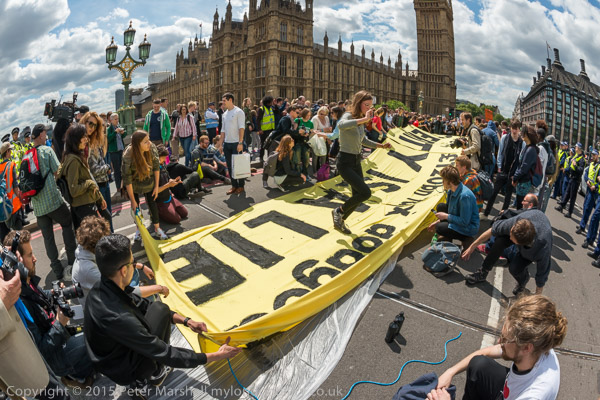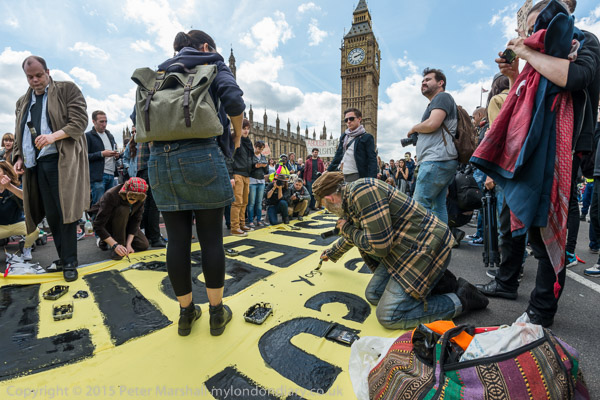
I don’t often use images taken with a fisheye lens without a partial ‘de-fishing’, but this is one case where I think it works. You can see some curvature in the image, but it isn’t excessive and I think helps draw the eye in towards the centre of the image.
Had that clock tower been further off centre its curve would have been more disturbing, and the same is true for the lamp post at the left. The clouds wrap around rather nicely and even the people close to the edge seem rather less distorted than is often the case. When I took it I was probably thinking that the figure a bottom left would move more into the corner and I would perhaps lose all or most of the two photographers cut off by the edge, as well as most of the empty space behind the white t-shirt at the right.

Most people who haven’t used fish-eye lenses think of rectilinear perspective as being somehow natural. It’s how we ‘see’ things, constructing images in our mind in which lines we know to be straight are straight. But it doesn’t work with making images with a very wide angle of view. The image above shows the result using the ‘distortion’ slider in Lightroom at 100%.
It crops the image a little at both left and right edges, and while it does straighten the lines, it makes their divergence much more apparent. That Canon lens at the left has roughly doubled in length and the head at bottom right is a rather more curious shape. What you can’t see in this small reproduction is the softness towards the corners where there just are not enough pixels to be stretched out like this. To be usable this image would need fairly drastic cropping.
If you must have a rectilinear view, stick to a rectilinear lens and avoid really extreme focal lengths. I have a 12-24mm full-frame Sigma lens, and anything below around 16mm I find seldom makes a usable image. It’s a better lens on DX, where the full zoom range can be used. A 16mm rectilinear image on full frame has a horizontal view of around 97 degrees, while the 16mm Nikon fisheye gives around half as much again, roughly 146 degrees.
The best we can do is to keep some straight lines straight, though we can also at the same time improve on the way that rectilinear perspective renders shapes across the frame, stretching them as they get away from the centre of the image.

The image above is the result of using the Fisheye-Hemi plugin for Photoshop, which is my normal ‘de-fishing’ tool. There are other things out there that do the same job, but the plugin is the most convenient I’ve found. It retains the image across the full width and height at the centre of the sides while losing some at the four corners, producing what I think is called a cylindrical perspective, like the rotating lens panoramic cameras I’ve also used.
As you can see, it also shows up the diverging verticals that result from my pointing the camera slightly down when making the image. But it does avoid the stretching at the corners and the softness which made the conversion to rectilinear a problem.

However I find that divergence annoying – and I didn’t see it in my viewfinder when I made the image. So I’d probably want to use Lightroom to remove at least most of this. Doing so means cropping the image (there is still a small amount of divergence, but not enough to be a nuisance.
It’s a usable alternative to the top image, but I still prefer that; the figure standing on the middle of the banner is a little more prominent, and for me at least seems more to be floating, almost as if she is being tossed up by those holding the banner.
I don’t know what Reuters and those other upholders of the unaltered image would think of all this. Would images whose perspective had been altered in the ways shown here still be accepted for World Press Photo? And I don’t greatly care. The uppermost image is what I saw in the viewfinder when I made the picture, but I think the bottom image is also a perfectly good record of the scene and my view of it. Probably a truer record of what I saw out of my left eye when I had the viewfinder pressed to the right.
The protest was to point out to Parliament that collecting taxes which are being avoided would bring in enough money to make cuts in public services unnecessary. You can see more pictures from it, including others taken with the 16mm Nikon fisheye as well as the 16-35mm rectilinear zoom and longer lenses at UK Uncut Art Protest.